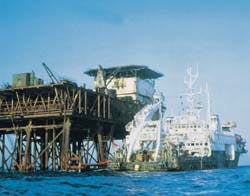FAST TRACK DEVELOPMENT EYED IN CASPIAN SEA
At issue is whether AIOC, by modifying idle facilities in the field, could start producing as much as 80,000 b/d of Chirag 1 oil by mid-1996.
State Oil Co. of the Azerbaijan Republic (Socar) 3 years ago installed a 20 slot, 10 pile drilling and production platform in 400 ft of water in the field, about 75 miles off Azerbaijan.
AIOC last September signed a production sharing contract (PSC) with Socar calling for phased development of Chirag and nearby Azeri and deep Guneshli fields. The PSC proposed phased development during 3 decades under an $8 billion plan (OGJ, Sept. 26, 1994, p. 48).
Combined reserves of the three fields are an estimated 4-5 billion bbl.
AIOC is a combine of companies led by Amoco Corp. and British Petroleum plc. Lukoil, Pennzoil Co., Den norske stats oljeselskap AS, and Unocal Corp. hold interests in the group.
AIOC in mid-May let a contract to Brown & Root Energy Services, Houston, to study the feasibility of developing Chirag 1 under a fast track schedule. Early production would provide an edge to Azerbaijan and AIOC in a region with many competing exploration and development plans.
FEASIBILITY STUDY
Brown & Root by summer is to put forth a plan to achieve Chirag 1 early production.
The company is to propose a project budget, schedule, work scope, and tender document. The package is to include a scheme to process Chirag 1 oil to meet standards for exports, along with a subsea pipeline to move oil to shore at Baku.
The scope of Brown & Root's feasibility study includes inspecting 20 oil processing modules, eight of which have been installed in the field. Azerbaijan's Shelfprojectstroy is fabricating the other 12 units at its Baku yard.
In addition, Brown & Root is to provide management support for AIOC's integrated team and for any subcontractors seeking to inspect Chirag 1 platform's jacket, deck, and piling system.
Brown & Root's Rockwater underwater engineering unit, working under a separate AIOC contract, used remotely operated vehicles last January to inspect the condition of the platform jacket. A team of Socar divers later inspected the structure based on findings of the ROV inspections.
AIOC has asked a few offshore contractors to prequalify for Chirag I engineering and construction.
EARLY OIL TRANSPORTATION
If fast track development of Chirag 1 is feasible, Brown & Root has proposed a stop gap plan to transport oil production to Supsa, Georgia, on the Black Sea for export to world markets.
Under that option, Chirag 1 oil would move by rail from Baku to Gachiani, Georgia. From there, crude would flow through an existing 20 in. line through Tbilisi, Georgia, to Supsa, where it would be delivered to a permanently moored 60,000-80,000 dwt floating storage and offloading (FSO) unit.. Tankers loaded at the FSO could carry oil through Bosporus Strait. Later expansion of the transportation link would include laying a line between Baku and Gachiani beginning by mid-1997.
In the first phase of the Chirag 1 transportation plan, pipeline capacity from Baku to Gachiani would amount to about 40,000 b/d. Phase 2 construction would boost capacity to about 120,000 b/d.
As currently conceived, total cost of the onshore pipeline dedicated to Chirag 1 crude would amount to about $250 million.
REGIONAL PIPELINE
Meantime, Brown & Root under a separate agreement is working on a program to develop a secure, efficient pipeline route to export oil from fields throughout the Caspian region.
The favored long term export scheme would involve shipping crude from Caspian fields to the southern Turkish port of Ceyhan at the eastern end of the Mediterranean Sea. With total cost estimated at $2.6 billion, the 1,275 mile pipeline system ultimately would be capable of moving 900,000 b/d of Caspian crude.
Brown & Root would begin developing the export route by laying a 30 in., 400 mile pipeline from Kazakhstan's Tengiz field, across the Caspian Sea, to Makhachkala, Russia. About 205 miles of the 400,000 b/d line would be subsea. A 185 mile pipeline would be laid from Makhachkala to move crude to Tbilisi.
In the first phase of the regional pipeline project, Caspian oil producers would be able to transport as much as 40,000 b/d of oil from Tbilisi 185 miles through an existing 20 in. pipeline to Batumi, Georgia, on the Black Sea.
In Phase 2 of the regional oil export plan, Brown & Root would lay a 30 in. pipeline from Tbilisi to Ceyhan.
In support of the proposed export route to the Mediterranean, Brown & Root said the option would:
- Accommodate future export needs of regional producers, including subsea tie-ins for continuing field development in the Caspian Sea.
- Allow a phased, flexible construction program without restrictions caused by winter in areas around the northern Black Sea.
- Avoid environmentally sensitive areas in the northern Caspian and near shipping lanes in the Bosporus Strait.
- Provide the shortest route independent of existing pipeline systems that will allow unrestricted tanker movements.
Copyright 1995 Oil & Gas Journal. All Rights Reserved.
